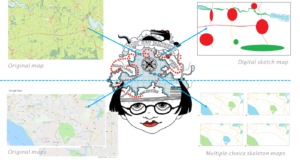Recent PhD thesis: Exploring the cognitive processes of map users employing eye tracking and EEG
As you know, we sometimes feature recently finished PhD theses here in the blog. While 2020 has been an odd year in many ways, several PhD candidates finished up their thesis, defended their thesis remotely, basically talking to a screen. Not really the best energy but we commend them all for their resilience and congratulate them for this gigantic life event. Among those was Merve Keskin, a member of our WG, and Merve has sent us the following text that summarizes her thesis. Enjoy, and happy 2021!
———————
Exploring the cognitive processes of map users employing eye tracking and EEG
Merve Keskin
Various research in cartography focused on how we see maps and how we derive meaning from them. When people need to perform a map related task (e.g. visuospatial search, route selection, navigation, distance estimation), they tend to memorize the relevant direct or indirect information on a map. Direct information could be about the location, name, shape, and size of objects, and indirect information is the spatial relationships among these objects. Next to the perceptual, cognitive, and visual abilities of individuals, the retrieval of a spatial information is linked with map learning. Map learning includes the processes of matching the map to the prior knowledge that already exists in memory and how map-learning task should be achieved. Each map user can develop their own strategy to approach the spatial information on maps.
To study the cognitive procedures during a map-reading task, various user-testing methods, such as sketch maps and eye tracking, contributed to understanding map users’ behavior. For instance, sketch maps represent the information extracted from a cognitive map through drawing and they reveal insights on the hierarchical structure of cognitive map processing and the amount of details of individuals’ cognitive maps. Eye tracking technique allows capturing users’ visual behavior in real-time and monitoring locations of fixations within images. Eye tracking metrics provide significant information on attention, cognitive load and task performance. On the other hand, EEG records the electrical activity along the scalp produced by the firing of neurons in the brain with high temporal resolution and relatively low cost. Eye tracking is used to detect overt attention through gaze movements, whereas EEG is more likely to detect covert attention through direct measures of the brain activity. As well as eye tracking, EEG suggests statistical and visual exploration of cognitive processes and has been commonly used in cognitive and experimental psychology. The cognitive theories and methods borrowed from psychology are very useful for cartographic usability research, especially when dealing with the issues caused by individual characteristics. However, cartographers rarely employed EEG to investigate cognitive issues of map users and cartographic products.
In my PhD research, I focused on how expert and novice maps users read, interpret and retrieve the visual information presented on digital 2D static maps from memory (i.e. spatial memory task) by conducting user experiments with sketch maps, eye tracking and EEG as synchronized and simultaneous data collection methods (Figure 1). Through the experiments, I aimed to measure the cognitive load when map users are asked to memorize and then remember the main structuring elements (i.e. roads, green areas, and hydrography) of map stimuli with varying levels of difficulty. In the retrieval stage, the participants were asked either to draw a sketch map or to choose the most suitable one from given maps (Figure 2).

Figure 1. A snapshot from an experiment

Figure 2. Spatial memory tasks in the experiments
Accordingly, visual variables used for depicting the main structuring elements in a map play an important role in spatial memory because we utilize them to design maps that can be used either with less or more cognitive load. To understand the influence of the visual variables on spatial memory, we considered the shape, size, color and location of the drawn elements on the sketch maps and their order of drawing. As reaction time and response accuracy were used as preliminary indicators of cognitive load, fixation-related eye tracking metrics (i.e. number of fixations per second, average fixation duration) and EEG power spectrum calculations (i.e. changes at alpha and theta frequency bands) were used to extract cognitive load.
Based on the results of our user experiments, we discovered that expertise is not as influential as we think when it comes to simple spatial memory tasks using maps designed for general audience like Google maps, and high cognitive load is not necessarily linked with low cognitive performance. However, experts and novices develop different strategies to approach the map-learning tasks and these needs to be researched in more depth including other individual characteristics affecting spatial cognition.
If you would like to have further information, you can read the thesis here: https://biblio.ugent.be/publication/8684280
Relevant publications:
Keskin, M., Ooms, K., Dogru, A.O., De Maeyer, P. (2020). Exploring the Cognitive Load of Expert and Novice Map Users Using EEG & Eye Tracking. ISPRS Int. J. Geo-Inf., 9(7), 429.
Keskin, M., Ooms, K., Dogru, A.O., De Maeyer, P. (2019). EEG & Eye Tracking User Experiments for Spatial Memory Task on Maps. ISPRS Int. J. Geo-Inf., 8, 546.
Keskin, M., Ooms, K., Dogru, A. O., & De Maeyer, P. (2018). Digital sketch maps and eye tracking statistics as instruments to obtain insights into spatial cognition. Journal of Eye Movement Research, 11(3).